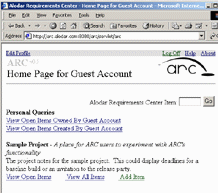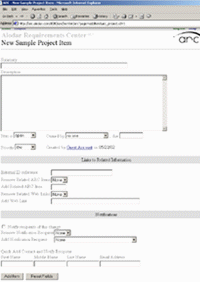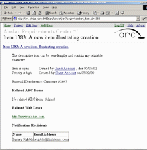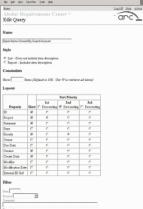
ARC demonstration
|
Overview
Alodar Requirements Center (ARC) is a web application for tracking action items. Alodar Systems, Inc. discovered a need for it while working on an integration engagement.
Issues often arise during the life of a project. The issue could be getting network accounts for the team or deciding the format for a customer name. Calling a meeting and inviting everyone who could have input for the answer might solve the issues. Although this could work, the logistics (not to mention the endurance) for this issue resolving approach would be a nightmare.
Instead of trying to answer the issues in real-time as a collaborative effort, a more practical way of attacking the problem is to assign the issue to a person. The person goes off on his own and tries to find the answer and reports back to the team. While trying to find the answer, other issues might creep up. When this happens, another issue is created and assigned to the same person or someone else. Sounds pretty efficient. But what happens when the assignee turns the issue into a science project? Or spends all his time on finding out what's the best color for the screen background instead of getting access rights to the database? The best solution for this type of confusion is to set clear expectations by assigning due dates and priorities.
Okay, here's the plan. As issues crop up, number them and assign them to individuals for resolution. Tag each item with a due date and a priority to get them resolved in a timely manner. Now what? It's no fun to periodically ping people to get the status. And waiting until the status meeting to review items usually results in having the items resolved in real-time which is where we started. A better solution is a database logging each item with a user interface to update the entries with status. This is exactly what the Alodar Requirements Center (ARC) provides.
ARC is a web application with a simple user interface for creating and updating action items. Items are grouped by project with a list of users that can read and read/write items. Each item has a short summary, description, creator, stuckee (more tactfully named owner), due date, and priority. When an item is created or when it changes, emails are automatically sent to a list of notification recipients and the creator and owner. ARC users can view reports and query for items.
You can continue reading to get more details on what ARC has to offer, or use ARC login and log on as guest with a blank password to take a look.
Quick Tour
Here's a quick walk through ARC.
Login
Use ARC login and log on as guest with a blank password to take a look. ARC uses a simple user name and password for login. The passwords can be stored internally to ARC or externally using the username and password of an Oracle database user for authentication.
ARC Administrators

|
These super users can create other users and projects, and administer existing projects. Unfortunately, administrative rights are not granted to the guest user.
ARC Home Page
After successfully logging into ARC, you're taken to a home page. This is where you see a list of all projects for which you have read access. As a guest user, you only have access to the sample project.

|
The name of the project is Sample Project and its description is A place for ARC users to experiment with ARC's functionality. Project notes are displayed below the name and description. Beneath the project information are links to viewing a list of open items, list of all items, addition of an item, and if the user has administrative rights a link to modify the project attributes and it's list of users.
Take a look at the rest of the page. You'll notice a link at the top left for editing the user profile. You can change the display name, email address, and password. In order to keep the guest account live, the Apply Changes button has been disabled.
Moving down the page, you'll see two links for viewing a list of items owned by Guest and the items created by Guest.
Tucked away on the right side of the page you'll see a field for entering an item number for quickly jumping to an entry.
Creating an item

|
From the home page, click on the Add Item link. You'll be taken to a new item page. Each item has a summary, description, status, priority, creator, owner, and due date. Item summaries are displayed in the list view and must be unique within ARC. You can add more descriptive text after creating the item, allowing for new information. Recall from the feature list that status and priority are configurable. For our implementation we use a status of open, closed, and obsolete. You could easily change it to new, in progress, in review, approved, and deferred.
An item also supports three types of related information links. External reference links are provided to enter an identifier to another system, for example it may reference a customer ID in a financial system or an invoice number in a billing system. Items can be linked to other ARC items and linked to Web addresses.
When an item changes you can elect to send email notifications to a list of recipients defined in ARC's address book.
Viewing items

|
After creating the item, you'll be taken to the item detail page. The detail page is also displayed when an item is selected from a personal or customized query. The page is suitable for printing.
ARC also has a list view for displaying multiple items on a single page. List views are displayed for personal and customized queries.
ARC's View Report feature displays multiple items in a detailed view.
Making your own queries

|
There are several built-in queries for viewing information and generating reports. Sometimes you'll want to search for items or have the data presented in an order different than the canned queries. ARC lets you do this. Just click on the Edit Query link from the personal query results page or the report page. You don't have to know SQL to build a query. The query name is used as the page heading for the result. You can include the lengthy descriptive text by selecting report or keep the result short by choosing list. Next, decide on how many items you want to see. Then pick the information you want shown and the order you want the items sorted. Almost done. Finally, enter in the search criteria as a filter. Get the results by clicking on Run Query.
Getting more information
You can read the ARC help files to get more detailed information or email if you have a specific question.